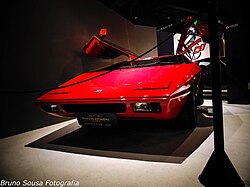Engineering:Hofstetter Turbo
| Hofstetter Turbo | |
|---|---|
| Overview | |
| Manufacturer | Hofstetter |
| Also called | Hofstetter Cortada |
| Production | 1984 |
| Model years | 1986-1991 (18 produced) |
| Designer | Mario R Hofstetter |
| Body and chassis | |
| Layout | Rear mid-engine, rear-wheel-drive layout |
| Doors | Gullwing doors |
| Dimensions | |
| Wheelbase | 2,380 mm (93.7 in) |
| Length | 4,170 mm (164.1 in) |
| Width | 1,740 mm (68.5 in) |
| Height | 1,070 mm (42.1 in) |
| |uk|Kerb|Curb}} weight | 1,120 kg (2,470 lb) |
The Hofstetter Turbo is a Brazilian car created in the 1980s by Mario Richard Hofstetter. In 1980 Hofstetter pulled out his drawing paper and started to draw a prototype of the car. Mario Hofstetter made this car at this time because the Brazilian government was very strict and didn't allow many imports into Brazil. In 1982 he started to put the mid-engined car together with some other workers, and began the Hofstetter company in 1984. Mario Hofstetter only was able to sell 18 cars throughout (1986–1991).
Performance
The Turbo featured a fiberglass body with gull-wing doors that was reportedly inspired by the Alfa Romeo Carabo concept car.[1] The interior was upholstered in leather and featured an early digital dash.[2] Early models of the Turbo were powered by a 1.8 L Inline-four engine from the Volkswagen Passat which was then equipped with a Garrett turbocharger and coupled to a 4-speed manual gearbox. These engines reportedly produced 140 hp (104.4 kW) at 5,000 rpm, and would accelerate the car from 0–60 mph (0–97 km/h) in 9.3 seconds and reach a top speed of 120 mph (193 km/h). Later models used a 2.0 L Inline-four engine out of a Volkswagen Santana that was also turbocharged with a Garrett turbo. This engine reportedly produced 210 hp (156.5 kW) and increased the top speed to 147 mph (237 km/h).[3]
External links
References
- ↑ "Best Cars Web Site - Páginas da História - Hofstetter". https://www.autolivraria.com.br/ph/154a.htm.
- ↑ "Hofstetter Turbo" (in en). http://www.thepetrolstop.com/2014/03/hofstetter-turbo.html.
- ↑ Mead, Derek. "Brazil's Hyper-Exclusive Gullwing Death Wedge" (in en-US). Jalopnik. https://jalopnik.com/5665575/brazils-hyper-exclusive-gullwing-death-wedge.
 |


